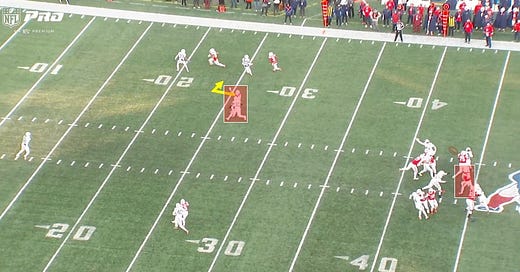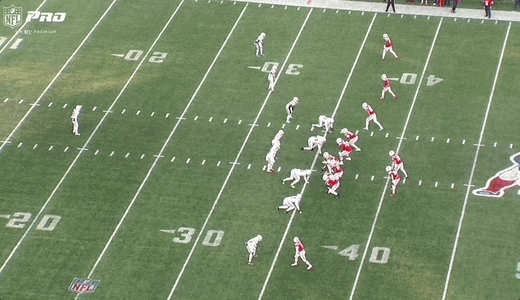Of the six first-round quarterbacks taken in the 2024 NFL Draft, Drake Maye showed the most improvement from college to his rookie season.
And that’s all the more impressive considering his situation in New England wasn’t great at all.
Receive breakdowns like this directly in your inbox by subscribing here:
The offensive line was one of the league’s worst. Despite a passing game designed to get the ball out of the quarterback’s hands quickly, they still finished 24th in pressure percentage allowed.
The receiving corps didn’t have anyone that made opposing defenses nervous, as evidenced by the fact that New England saw the 5th-highest frequency of man coverage according to
of .Still, Maye made the most of his situation.
I want to be clear here before I sing Maye’s praises. He didn’t exactly have a “great” rookie season. He certainly wasn’t Jayden Daniels adjacent or anything. I also didn’t come away from his first year in quite the same way I did after watching players like Justin Herbert and Joe Burrow in 2020, for instance.
With those two, despite the poor situations and team results, it was clear that they would become top-tier quarterbacks at some point in year 2. They made so many “wow” throws throughout their rookie seasons. With Herbert, it was more his physical talent leading the way. With Burrow, it was his timing, anticipation, and pocket presence.
With Maye, I didn’t see a ton of those “wow” throws throughout his rookie season.
What I did see, though, was a quarterback who had mitigated the issues that were most concerning in college. He was less erratic with his ball placement. His pocket presence and instincts weren’t quite the problem they were at UNC. He played with much better timing and rhythm in general.
Most importantly, he just looked like a quarterback who belongs in the NFL and could run an offense efficiently. That was not a takeaway I was expecting to have entering the season.
The below play serves as a great example of this. The Patriots were facing a 3rd-and-6 vs. the Colts in Week 13, and Indy would bring a 6-man pressure. Maye was calm in response, even with a free rusher bearing down on him. He stood firm as if there was no rush and delivered an accurate strike against tight-man coverage:
Look at the anticipation on this throw too. The ball was out and his receiver still hadn’t even gotten out of his break yet:
I highlighted a play like this because this is not the Drake Maye I saw in college. He needed a lot of functional space, was quick to bail vs. pressure, and was inconsistent with his ball placement, particularly on short-to-intermediate throws. This play, and many others like it, were the complete opposite of that.
And more importantly, this type of execution is what’s needed to keep the offense on the field. This is the type of throw that translates to productive quarterback play at the NFL level regardless of the defense or opponent. And that will be critical once the Patriots start playing in meaningful games again.
A big part of Maye’s improvement was offensive coordinator Alex Van Pelt. I know he got fired after the season, but he did a great job with Maye all things considered.
Van Pelt was hell-bent on getting the ball out of Maye’s hands with quick, short throws. According to PFF, Maye was 14th in the NFL in percentage of throws behind the line of scrimmage, 6th in percentage of throws between 0-9 yards from the line of scrimmage, 35th on throws 10-19 yards, and 34th on throws 20 yards or more.
This was the right approach given the O-line situation and because that’s how Maye had to learn to play the position to be an effective NFL quarterback.
Van Pelt’s approach did play somewhat of a role in masking Maye’s issues from college. Generally, the later in the play he held the ball at UNC, the worse he was from the pocket. That applied to his timing, ball placement, and pocket movement.
Under Van Pelt, though, the ball was out. As a result, Maye didn’t have as many snaps where had to navigate the pocket while waiting for his receivers to break open. He didn’t have as many plays where he needed to deliver at the intermediate level later in the down.
I know Josh McDaniels runs a similar system to what Maye experienced last year in the sense that quick, rhythmic throws are a staple. But the offense will evolve into something where Maye has to hold the ball longer and go downfield more often. That’s especially true since the Patriots appear likely to have a better offensive line and more weapons around Maye than they did during his rookie season.
So will the issues we saw at UNC crop back up in year 2 or beyond as he’s able to hold the ball longer? That will be the thing to watch this year, in my opinion.
Drake Maye Film Session
We’re starting a new section on Football Film Room called “The Film Room” (our marketing team really went deep to come up with that one). There, I go into more depth on Drake Maye and take you through 50 plays from his rookie season.
We plan on adding more breakdowns like this moving forward. The first 10 plays or so are free to view, but you’ll need a Founding Member subscription to see the rest.
Click here to check it out: Drake Maye Film Session.
And remember, a Founding Member subscription also gets you access to our playbook with over 70 breakdowns grouped by concept (e.g. passing game, running game, situational, coverages, pressures, etc.).





